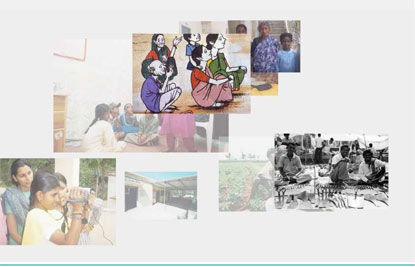The pieces came together today at the DIS 2008 conference – or at least closer together. So far, human-computer interaction has focussed on things like cognition, efficiency and matching existing work practice. But maybe we’ve got that pretty much that stuff sorted out – at least from a researcher’s point of view. Our curiosity is leading us towards a new frontier: how interactive technology can address the social and emotional aspects of our lives.
Matt Jones from Swansea University talked about the StoryBank project. The team has placed a digital screen in the centre of a rural Indian village to help people share knowledge in the form of stories. Participants can create a simple story on their mobile phones, made of still photos and audio, then “gift” it to the StoryBank screen. They can apply simple tags to the story using icons: “kids”, “farming”, “health” humour”… Other villagers can discover stories floating past on the screen, and view them or download them onto their own phones. The villagers have limited literacy, an extroverted culture and a strong tradition of sharing knowledge through storytelling. They have taken to the screen enthusiastically.

Eric Paulos, from Intel Research, talked about “Objects of wonderment”. He asked us to consider how technology can create a sense of wonder, rather than just being a practical problem solving tool. He also asked us to rethink our understanding of mobiles phones and consider them as “public urban processors” – cheap, ubiquitous, connectible modules of computing power attached to humans that move them around the city. This situation allows amazing phenomena to emerge – when it can be harnessed.
The objects of wonderment project has provided a tool kit to enable people to re-use old mobile phones and extend them to do new things. The example: the Hullabaloo – a phone in a box, attached to a loudspeaker. Whenever it detects a new bluetooth ID drifting past (another phone and its owner) it assigns a new bird call sound clip to that person and plays the bird call. Regular passers-by start to be able to identify their own bird call – and that of other regulars.

John Williamson from the University of Glasgow, demonstrated a fun way to browse and explore a large digital photo collection. You literally shake the screen of his hand-held Flutter interface to bring up a new selection of photos, then grab a pleasing photo with the stylus and shake that to release other similar photos.

Factors for designing social and emotional experiences
The conversation after a number of talks touched on questions like “Who would want this?”, “Where would this be worth doing?” And compiling ideas from many talks, I ended up with this short list of factors to consider when designing social and emotional experiences. For social experiences:
- Culture: Are you designing for a culture which values the group or individuality more highly? Consider, also, attitudes to family – so different between say, Singapore and the UK.
- Individual differences: Different people have different tastes and behaviours. A given emotional experience is unlikely to appeal to everyone (and why should it?)
- Physical proximity: Is the experience designed to work over a wide distance, or to help people communicate and collaborate better when they are standing right next to one another? If people are together – why? Are they there to collaborate or join in community or entertainment activities, or are they forced together by circumstance? On a crowded train, people use inteactive devices like ipods to separate themselves from the crowd and create much-needed personal space. But at a festival or market, people have deliberately come along to interact with each other.
For emotional experiences:
- Physicality: Physical movement, be it whole-body or just smaller movements, is often playful and can make an experience joyful.
- Where the emotion is: Should the system seek to identify the users emotion, and do something with that “knowledge”? Or should it simply act as a medium for gathering, storing and sending new kinds of material that will produce an emotional responses in the users (yesterday’s sensecam story is a great example of this second approach).
Identifying all the variables involved in creating social and emotional experiences is going to take plenty more effort and experimentation. But everyone at the conference accepted that the user-centred design approach, involving users throughout the design process, is the only way to learn. For these cutting edge designers and researchers, UCD is a given.
The third wave
Bill Gaver, from Goldsmith’s in London, summed up what’s happening. A third paradigm for HCI is emerging (though I’m not yet clear what the first two were). This new paradigm defines interaction design as “situated meaning making” – not only improving efficiency, or matching user needs better, but also adding the emotional and social ingredients to make an experience worthwhile.
Some of Bill’s tips:
- Design situations and resources, not tools. In other words, challenge people to think in new ways and give them what they need to make progress.
- Make the world interesting, not the system.
- Interaction can be in the mind. There’s not always a need for bells, buttons and sliders if the interface can make you think about the world in a new way.
- Welcome ambiguity and a variety of interpretations, don’t view them as error or risk. People have always interpreted and appropriated systems – however rigorously they are designed. This new wave of HCI acknowledges and welcomes it.
To see what he means, take a look at this video (6 mins) of Bill’s latest project being evaluated by its users. It’s great fun, and fascinating.
And is this approach commercially applicable? Sometimes.
- Interesting interaction can be used to attract attention.
- Devices that create emotion or promote reflection might be desirable. I’d buy a SenseCam.
- We know that emotional connections create brand loyalty. Many Apple users have a strong emotional connection to their computers and the Apple brand. A little of that comes from playful user experience.
But is it art?
It all seems perilously close to art. And surely there are serious limits for this new kind of HCI. Would you prefer to know that the pilot has full control of the plane, or that he has emotional relationship with it, and can interpret its signals to him in a range of ways? Bill points to some intriguing examples:
- The Shared Space project has found that removing road markings and street furniture, to make an intersection ambiguous actually makes people think differently and take more care there.
- And maybe an engaged pilot, who finds his aeroplane eternally interesting is safer than a bored one, or one who has little interaction with his plane until the autopilot suddenly fails.
And how will the new HCI be branded? HCI 3.0? Situational HCI? Now that’s the really hard part…